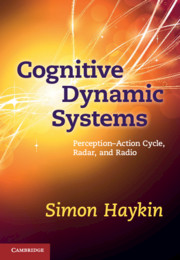Book contents
- Frontmatter
- Contents
- Preface
- Acknowledgments
- 1 Introduction
- 2 The perception–action cycle
- 3 Power-spectrum estimation for sensing the environment
- 4 Bayesian filtering for state estimation of the environment
- 5 Dynamic programming for action in the environment
- 6 Cognitive radar
- 7 Cognitive radio
- 8 Epilogue
- Glossary
- References
- Index
3 - Power-spectrum estimation for sensing the environment
Published online by Cambridge University Press: 05 June 2012
- Frontmatter
- Contents
- Preface
- Acknowledgments
- 1 Introduction
- 2 The perception–action cycle
- 3 Power-spectrum estimation for sensing the environment
- 4 Bayesian filtering for state estimation of the environment
- 5 Dynamic programming for action in the environment
- 6 Cognitive radar
- 7 Cognitive radio
- 8 Epilogue
- Glossary
- References
- Index
Summary
As discussed in Chapter 2, perception of the environment is the first of four defining properties of cognition, putting aside language. To cater for perception in an engineering context, we not only need to sense the environment, but also focus attention on an underlying discriminant of the environment that befits the application of interest. In this chapter, we focus attention on spectrum estimation, which is of particular interest to sensing the environment for cognitive radio. Moreover, with radar relying on the radio spectrum for its operation, spectrum sensing is also of potential interest to cognitive radar.
With spectrum estimation viewed as the discriminant for sensing the environment, there are four related issues that are of practical interest, each in its own way:
(1) Power spectrum, where the requirement is to estimate the average power of the incoming signal expressed as a function of frequency.
(2) Space–time processing, where the average power of the incoming signal is expressed as a function of frequency and spatial coordinates.
(3) Time–frequency analysis, in which the average power of the signal is expressed as a function of both time and frequency.
(4) Spectral line components, for which a special test is needed.
Throughout the presentation, the emphasis will be on the use of a finite set of observable data (measurements), which is how it is in practice.
In Section 2.12 we stated that perception in a cognitive dynamic system may be viewed as an ill-posed inverse problem.
- Type
- Chapter
- Information
- Cognitive Dynamic SystemsPerception-action Cycle, Radar and Radio, pp. 43 - 76Publisher: Cambridge University PressPrint publication year: 2012



